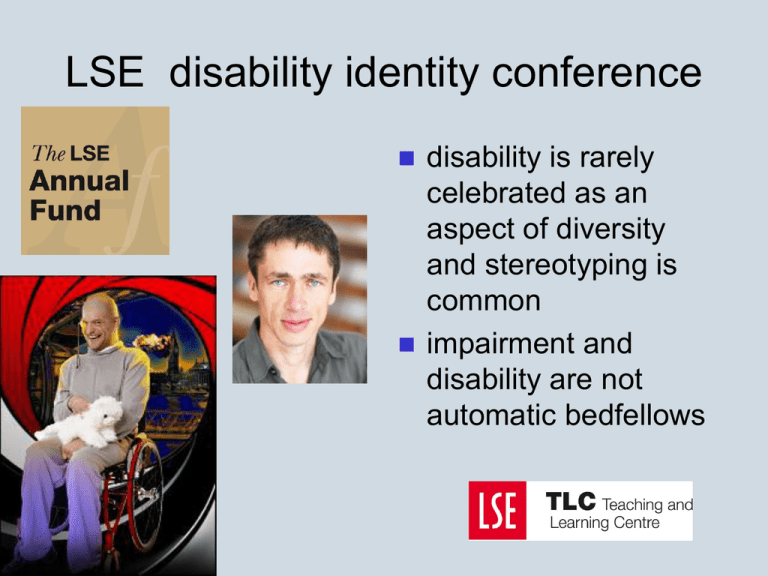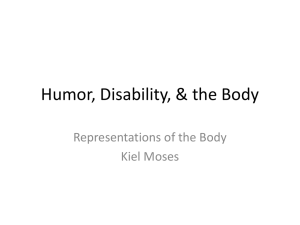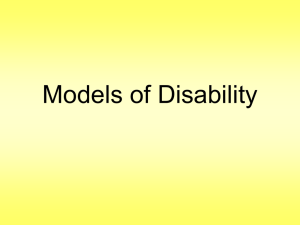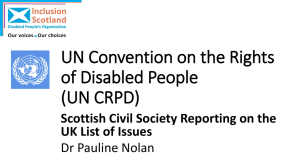Disability Identity Conference
advertisement

LSE disability identity conference disability is rarely celebrated as an aspect of diversity and stereotyping is common impairment and disability are not automatic bedfellows The Equality Act 2010 ‘framework for a fairer future' recognises multiple identity including dual characteristics includes discrimination by association and perception streamlines legislation protected characteristics-race, gender disability, age, sexual orientation, religion and belief, gender reassignment, pregnancy and maternity, marriage and civil partnership majority world 600 million people disabled globally (1 in 10) 80% located in majority world countries mainly living below the poverty line conflict and poverty are major causes – (UNESCO) please refer to Emily Freeman’s slides in the pack UN convention (article 1) to promote, protect and ensure the full and equal enjoyment of all human rights and fundamental freedoms by all persons with disabilities, and to promote respect for their inherent dignity 'dominant groups in society reduce minority culture to discourse of the other' (Peeters 2000:588) 'the expression 'special needs' puts together two of the terms most commonly used in patronising euphemisms. Special segregates' (Valentine 2002:220) Time to Change http://time-to-change.org.uk/ Erik Baurdoux e.j.baurdoux@lse.ac.uk Lecturer in Statistics, LSE A social movement for mental health: individual support 50,000 + Facebook fans 25,000 + supporters on our database 14,000 + pledges Celebrity supporters: Stephen Fry, Ruby Wax, Ulrika Jonsson, Alastair Campbell, Fiona Philips, Frank 2010: Introducing you to your prejudice Getting people to recognise their part in the problem Thank you e.j.baurdoux@lse.ac.uk http://time-to-change.org.uk/ Invisible / Visible Disability Erin Pritchard, Newcastle University Disability and Stereotypes Jade: … I had wheelchair user tell me off once for using a disabled toilet, because I wasn't in a wheelchair. I explained how I couldn't reach the sink, the lock, the dryer or see the mirror. She still didn't think that they were also for us, because that symbol seems to say that it is specifically for them. There are four groups of disabled people in this country, one you've got some sort of very obvious facial or physical impairment such as a limb missing. Then there are the people with learning disabilities, then the ones with sensory impairments and then the wheelchair users. We don't fit into any of those so we are not really disabled, yet we have the same barriers and attitudes but probably a bit worse in some ways...Yet, we are not considered disabled by the disabled community and by the wider community. It's not a case of degrees of disability and who is more disabled than others but people just don't get where we fit in. Social Model The social model does not deny the problem of disability but locates it squarely within society. It is not individual limitations, of whatever kind, which are the cause of the problem but society’s failure to provide appropriate services and adequately ensure the needs of disabled people are fully taken into account in its social organisation. (Oliver, 1996, p. 32) Psycho-emotional Disability Psycho-emotional dimensions of disabilism refer to barriers which affect who people can be; for example dealing with the thoughtless comments and stares of strangers which can leave people with impairments feeling psychologically and emotionally undermined (Reeve, 2006) Dwarfism and misrepresentations Dwarf humour is historically common with origins in the circus and is still evident in contemporary comedy in a way that racist humour probably isn’t (Martin, 2010). Identifying themselves as disabled Self-identity arises from social interaction with others – how we see ourselves is affected by how others perceive and react to us (Reeve 2006). The ways in which people with impairments see themselves as disabled or not is affected by interactions with other people (ibid). The Normal Body ‘…the most spectacular form of visual novelty that can prompt stares are breaches of the common human scale and shape.’ (Garland-Thomson 2009: 161) Conclusion Dwarfs experience both physical and social barriers which disable them Society needs to be more aware of the various disabilities that exist References Deal, M. (2003) Disabled people’s attitudes towards other impairment groups: a hierarchy of impairments Disability and Society 18 (7) 897-910 Garland-Thomson, R. (2009) Staring, Oxford University Press Grosz, E.(1991) Freaks Social Semiotics 1 (2) 22-38 Imrie, R. (1996) Disability and the City Salisbury: The Baskerville Press Kruse, R. (2002) Social spaces of little people: the experiences of the Jamisons, Social and Cultural Geography 3 (2) 175-191 Kruse, R. (2003) Narrating Intersections of gender and dwarfism in everyday spaces The Canadian Geographer 47 (4) 494-508 Martin, N. (2010) A preliminary study of some broad disability related themes within the Edinburgh fringe festival Disability and Society 25 (5) 530-540 Oliver, M. (1996) Understanding disability: from theory to practice Basingstoke, Palgrave Press Reeve, D. (2006) '‘Am I a real disabled person or someone with a dodgy arm?’: A discussion of psycho-emotional disablism and its contribution to identity constructions', paper presented at Disability Studies: Research and Learning, Lancaster University, 18-20 September. Shakespeare, T., Wright, M. and Thompson, S. (2007) A Small Matter of Equality: Living with Restricted Growth. Newcastle University The Holist Manifesto Challenging the social construction of specific learning ‘difficulties’ Paradox On the one hand, we are: On the other hand: humiliated, categorised, mislabelled, psychologised, patronised, invalidated, bullied, medicated, outcast and imprisoned Disabled Expertise: science, sport, ICT, mathematics, leadership, comedy, acting, creative arts and architecture Paradigm shift laterality meaning ‘Working Memory Difficulties’ “I have a terrible memory….I get upstairs and can’t remember what I’m here for…” ….I can’t remember names, it’s embarrassing…” ….I can’t remember my pin number, it’s so annoying….” The Myth of ‘Working Memory Difficulties’ Information can be processed Sequentially or Holistically requires Working memory Imagination We have great Memories for Meaningful information…. How things are structured…. How things feel…. The Bagatelle Model Identity is forged …in the Bagatelle of life …through the comments of significant others …through self perception of strengths and difficulties This divides us into distinct categories when we have more in common that we have Neurodiversity: ‘Overlapping conditions’ Dyslexia AD(H)D Dyspraxia Dyscalculia Dyslexia AD(H)D Dyspraxia Dyscalculia Socio-economic underpinning This disabling process is held in place by the primary social function of education: …to fail a significant population and persuade them it’s their own fault. Education is both a class allocatory device and designed to give the appearance that we live in a meritocracy…. Reproduction of social power relationships depends on: schools determining : 1. What is to be learned (and what is not) 2. In what order 3. At what time. 4. And how it is ‘assessed’ “the imposition of cultural arbitraries” Bourdieu Reproduction of social power relationships depends on: schools determining : 1. What is to be learned 2. In what order 3. At what time. 4. And how it is ‘assessed’ This enables sufficient failure, through controlling the rules of sequence and the boundaries we have to observe. It then leads to ‘neurocentrism’. We are unintended casualties It is time to change the social construction of specific learning ‘difficulties’! No-one will do it but us…. (we have nothing to lose but our difficulties!) The Holist Manifesto Principles Demands Vision Principles We are all neurodiverse. ‘Neurotypical’ is a myth. The dyslexic experience is but one experience among many that have the same underlying cause: a systemic intolerance to holistic thinking. Without us there would be an impoverished world for all We are entitled to be different and to learn and work differently. All of us with specific learning differences are disabled by an intolerant world. Changing it requires solidarity among us all. Changing it changes it for the better for all. We Demand that: There must be no policies about neurodiversity, except those developed by and with those people most affected by the policy implementation There should be no teaching intervention without representation- we have had enough of the tyranny of ‘experts’. There needs to be a zero tolerance to linear measures of humanity and the insistence on linear sequential teaching and communication strategies Our Vision The future of the world depends on allowing us to be different and to learn and work differently. This involves: – High interest learning based on passionate interest, rather than an insistence on learning ‘the basics’. – Flexible teaching that values purpose and personalised timing, and ends the herding of children together by age to ‘learn’ a national ‘curriculum’ – Nurturing the free association of ideas – Encouraging problem solving, thinking outside the box, and the creation of solutions rather than limit academic study to the critique of others’ ideas. The Holist Manifesto Challenging the social construction of specific learning ‘difficulties’ Unseen Disabilities: How to Cope with Invisible Disabilities as an Undergraduate Nathan Gyebi-Ababio Presentation Summary 1. History of Medical Condition: 2008 - 2011 2. Impacts on Undergraduate Life at University 3. Impacts on Social Life at University 4. Coping Strategies: Managing Unseen Disabilities at University History of Medical Condition: 2011 Undergraduate2007Study Begins: October 2007 – BSc Government: Very Interesting Course – Flu-Like Symptoms in December 2007 – Severe ill health during Examination Period Diagnosis: Lupus Nephritis (SLE) – Chronic and presently-incurable illness of the immune system – Commonly causes damage to the Skin, Joints and Kidneys – Can be fatal depending on the severity of the diagnosis – Medication Requirements History of Medical Condition: 2008 2011 Second Year: 2009 – Completed Three of the Four 1st year Examinations – Failed One – Carried over Two units into 2nd Year of Studies – Completed Six Examinations in 2008 – Severe Flare Up (September 2009) Final Year: 2011 – Rehabilitation: One Year Suspension of Studies (2010) – Begin Final Year in October 2011 University 1. 2. 3. Explaining my Condition – Who do I tell? – How much do I disclose? – Does it matter if I struggle? Adapting to the changes in Physical Health – Pains and aches – Extreme Fatigue – Insomnia Lack of focus during Lectures and Studies – Medication Intake – Side Effects Impacts on Social Life at University 1. General Awkwardness – Struggled to adjust to medical condition – Lack of Self-Confidence – Anxiety in Social Environments 2. Difficulties in Communication – Incoherent Speech: Stuttering – Sentence Construction Deterioration – Short Attention Span: Forgetfulness HAP Coping Strategy: Managing Unseen Disabilities at University 1. Honesty – Be Realistic: Accept what you can and cannot do – Be Helpful: Ensure the people that matter know your situation – Be Pragmatic: Approach work and assignments in sensible manner 2. Awareness – Anticipate what work you will get – Plan further ahead than other students – Give relevant members of staff advanced notice regarding extensions/difficulties – Always keep evidence of all appointments/medical prescriptions 3. Patience – Never stress about a situation you cannot change (Missed Readings and Essays) – Understand the nature of your disability – Relax: Members of Staff are always available at University to help YOU CONCLUSION Honesty Communicate honestly about your disability with your tutor, teachers and fellow undergraduates when necessary. Awareness Be self-Aware; come to terms with your limitations and work beyond them. Patience Understand that the more patience you have; the more productive your studies will become. Just because it is unseen does not mean that it should go unheard. Disability History Fast Facts Modern Era and Disability Activism K.S.Beninger. May 2011. Victorian Era Empire, eugenics and segregation 1859 Darwin's theories of evolution and the notion of the survival of the fittest through natural selection led to the widespread and apparently scientifically justified view of disabled people as inferior. This view fuelled the trend for segregation. 1883 Sir Francis Galton introduced the notion of eugenics. Early 20th Century Unions, organisation and the Great War 1907 The eugenics movement gains influence on popular opinion in the USA. Between 1907 and 1943, 30 states passed sterilization laws aimed at various “social misfits: the mentally retarded, criminals and the insane.” School medical inspections made compulsory. 1913 Mental Deficiency Act sets out to segregate people with 'mental handicap' and prevent procreation which would "repeat their type". 1914 The outbreak of war in Europe meant huge numbers of injured soldiers returning home requiring support and 'rehabilitation'. The 1920s - 1930s Protest, war veterans and the Final Solution 1920 A national protest march by blind workers against low wages and poor working conditions. 1935 The League of the Physically Handicapped formed in New York City to protest discrimination by the Works Progress Administration (WPA). The league's 300 people -- most disabled by polio and cerebral palsy --all had been turned down for WPA jobs. They eventually generated a couple of thousand jobs nationwide. 1939 WWII. Approx. 140,000 disabled people were to be murdered by Germany's Third Reich, along with Jewish people and many other minority groups as part of Adolf Hitler's 'Final Solution‘. The extermination of disabled children and adults in Nazi Germany became known as the T4 Project. Charitable Foundations in Germany helped to select candidates for 'euthanasia‘. 1932 The 1940s and 1950s Charities, Beveridge and the Welfare State 1942 Beveridge Report published, calling for a new social insurance system which will conquer the "five giants" of Want, Ignorance, Squalor, Idleness and Disease. 1944 The Disabled Persons (Employment) Act. The Act made provision for a disabled persons' employment register and the 3% disabled employee quota for companies employing more than 20 workers. The British Council for Rehabilitation of the Disabled is founded. 1948 The National Health Service Act and the National Assistance Act: the Labour government constructs the 'welfare state' with the introduction of the National Health Service and the National Insurance scheme. 1954 The Spastics Society is formed - continuing the trend for parent and carer-led charities. The 1960s and 1970s Roots of Empowerment and SelfDetermination 1960 A national rights demo by the Physically Handicapped Association. The first Paralympic Games were held in Rome and have been held in every Olympic year since. 1961 American President Kennedy embraces a principle of normalization in his push for community services to manage “the problems of mental retardation.” 1970 Independent Living Movement gains momentum in North America, led by disabled persons. The 1960s and 1970s Roots of Empowerment and SelfDetermination 1972 A disabled person, Paul Hunt, writes a letter to The Guardian newspaper calling for equality for disabled people. His letter inspires the start of a united struggle against discrimination. E-mail is invented by a hearing impaired person named Vinton Cerf. 1973 The Rehabilitation Act was the first attempt to introduce anti-discriminatory legislation in the USA. 1975 United Nations Declaration of the Rights of Disabled Persons, calls for full economic and social integration of disabled people. DIRECT ACTION mobilising disabled people to demonstrate against injustice Collective mobilization amongst disabled persons led to the rise of political activism in the modern era. Disabled People's Direct Action Network (DAN) is Britain's premier civil rights group and is changing the way disabled people in Britain are perceived by demanding civil rights, not charity or pity. 1970 USA advocacy organization ‘Disabled in Action’ (DIA) formed. March on Washington to protest for the amendments to the Vocational Rehabilitation Act, protests at inaccessible buildings, protest Jerry Lewis paternalistic, pity-oriented telethons Cross-disability advocacy secured the Americans with Disabilities Act (USA) Direct Action & Awareness Abnormally Funny People International Disability Rights Milestones 1990 Americans with Disabilities Act passed after concerted effort by a coalition of mental, physical and sensory disability rights groups 1994 UN adopts Standard Rules on the Equalization of Opportunities for Persons with Disabilities, setting international guidelines 1995 Britain's’ Disability Discrimination Act enacted, mandating reasonable adjustments to policies and physical environments of employers with disabled employees 2006 UN Convention on the Rights of Persons with Disabilities – ‘disability is an evolving concept…results from interaction between persons with impairments and attitudinal /environmental barriers that hinder full effective participation in society on an equal basis with others’ Other legislative activity promoting rights of disabled people: Australia, Germany, Austria, Finland, Brazil, S. Africa, Malawi, Uganda and Philippines. Legislation A map of the world showing coverage of the UN convention on disability. 147 signatories,99 ratifications. Models of Disability in Transition Biomedical Social Individual/medical Socio/political Medicalizes the experience of impairment. Searches for cures, means of reducing impairments, or assessments of clinical interventions. Impairment is a physical fact but disability is a social construction. Affirmative Action? Recognition of impairment as an ordinary, rather than an extra ordinary characteristic of human experience.



![You can the presentation here [Powerpoint, 1.01MB]](http://s2.studylib.net/store/data/005417570_1-0810139cfc2485ebcaf952e0ae8bb49a-300x300.png)

![[USE POSTER DESIGN] - the NCRM EPrints Repository](http://s2.studylib.net/store/data/005470487_1-218dd30af4c06da853552f9c41301e82-300x300.png)


